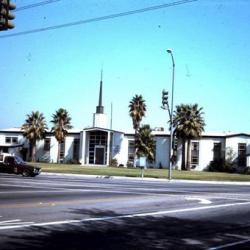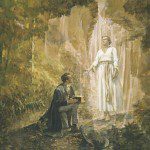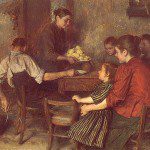
(Wikimedia Commons public domain image)
***
We spent much of today up in Bountiful with my wife’s father, one of our sons, my brother- and sister-in-law, and a niece. It was nice to see them again and to catch up. We visit my father-in-law pretty much weekly, even taking our travels into account, but some of the other family members have been more elusive. So this was very nice.
***
With the patchy and inadequate access to the internet that so frustrated me during my recent trip to Egypt, I lost track of which new items on the Interpreter website I mentioned here and which new items I failed to mention. Here are some that I’m pretty confident I didn’t write about on this blog. If I did, I apologize; I’m just trying to catch up:
The Interpreter Radio Roundtable for Come, Follow Me Doctrine and Covenants Lesson 51, “The Family Is Central to the Creator’s Plan,” on The Family: A Proclamation to the World, featured Neal Rappleye, Jasmin Rappleye, and Hales Swift. This roundtable has now been extracted — freed from advertisements and other irrelevancies and interruptions — from the 7 November 2021 broadcast of the Interpreter Radio Show. The complete episode may be accessed at https://interpreterfoundation.org/interpreter-radio-show-November-7-2021/. The Interpreter Radio Show can be heard every week on Sunday evening from 7 to 9 PM (MDT), on K-TALK, AM 1640, or you can listen live on the Internet at ktalkmedia.com.
Kyler Rasmussen, “Estimating the Evidence Episode 22: On the Book of Abraham”
[Editor’s Note: This is the twenty-second in a series of 23 essays summarizing and evaluating Book of Mormon-related evidence from a Bayesian statistical perspective. See the FAQ at the end of the introductory episode for details on methodology.]
It seems unlikely that the Book of Abraham would disagree with what the most learned academic minds would have to say on the subject, or that a fraudulent one could in any way align with what we’d expect from the ancient world
During 1978, 1979, and 1980, Hugh Nibley taught a Doctrine and Covenants Sunday School class. Cassette recordings were made of these classes — some of which have have survived. These were recently digitized by Steve Whitlock. Most of the tapes were in pretty bad condition. The original recordings usually don’t stop or start at the beginning of the class and there is some background noise. Volumes vary, probably depending upon where the recorder was placed in the room. Many are very low volume, but in most cases it’s possible to understand the words. In a couple of cases the ends of one class were put on some space left over from a different class. Even with these flaws and missing classes, we believe these these will be interesting to listen to and valuable to your Come, Follow Me study program.
Terry Hutchinson and Martin Tanner were the discussants on the Interpreter Radio Roundtable for Come, Follow Me Doctrine and Covenants Lesson 50, “We Believe” on The Articles of Faith and Official Declarations 1 and 2. This roundtable was extracted from the 31 October 2021 broadcast of the Interpreter Radio Show. The complete show — carefully shorn of commercial and other interruptions — may be heard at https://interpreterfoundation.org/interpreter-radio-show-October-31-2021/. The Interpreter Radio Show is broadcast every Sunday evening from 7 to 9 PM (MDT), on K-TALK, AM 1640. Alternatively, you can listen live, from absolutely anywhere via your computer, on the Internet at ktalkmedia.com.
***
This is a brief but interesting read:
“Lessons learned from black-and-white visions of Christmas past – movies from 1940s”
***
If you get the chance, watch BYU Television’s film about the creation of G. W. F. Händel’s great oratorio Messiah:
http://byu.imodules.com/redirect.aspx?linkID=60353&eid=1273091
You’ll never hear the aria “He was despised” quite the same way again.
Even the New York Times gave the documentary a reasonably positive review: http://www.nytimes.com/2014/11/27/arts/television/the-making-of-handels-messiah-on-byutv.html?_r=1.
***
The first recording of Do You Hear What I Hear? was made by the Harry Simeone Chorale shortly after Thanksgiving 1962, and sold so well during that Christmas season that Bing Crosby eventually recorded it also — making it, by means of his star power, a mega-hit.
Here is that very first choral recording:
https://www.youtube.com/watch?v=JmYIbKqH45A
The song had been composed only a month or so before, during the thirteen days of the Cuban missile crisis of October 1962, when — and I still have vivid childhood memories of this — the world seemed to be within hours of a nuclear war between John F. Kennedy’s United States and Nikita Krushchev’s Soviet Union. It was written as a plea for peace, and that can clearly be heard in the words.
The lyrics of the song are constructed somewhat like a game of “telephone,” with the news of Christ’s birth being related by the night wind to a lamb, by the lamb to a shepherd boy, by the shepherd boy to a king, and by the king to people everywhere. At each level, the nature of the message changes somewhat, becoming more specifically focused on Christ.
***

(Wikimedia Commons public domain photo by Humphrey Bolton)
The so-called “Wexford Carol,” which comes from Ireland’s County Wexford and which seems to date back to the twelfth century, may be among the oldest Christmas carols — and, thus, among the oldest pieces still performed — in the Western musical tradition:
https://www.youtube.com/watch?v=2b6URDdh_7A












